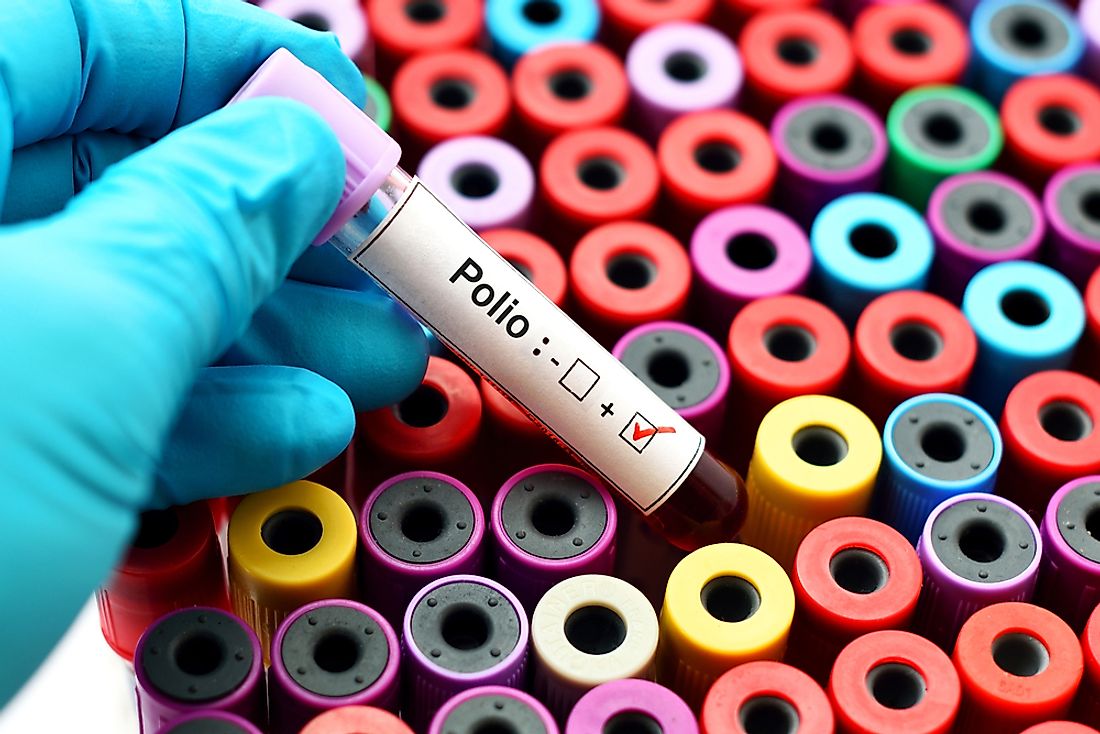Polio Rates Over Time

Large-scale vaccination programmes have enabled the near eradication of polio. The World Health Organization together with the Rotary Foundation and UNICEF spearheaded efforts to eliminate polio infection rates across the world. This campaign, which commenced in 1988, has been tremendously successful having managed to reduce the infection rates from 35,251 in the first year to 37 in 2016. If polio is eliminated, it will be the third time such a feat has been achieved after smallpox and rinderpest. Nigeria, Pakistan, and Afghanistan remain the only nations where polio is endemic.
Polio Rates Over Time
Before 1988
Although the history of polio infection dates back into prehistory, it was not until the 20th century that major polio epidemics came to be known. Europe suffered major epidemics in the 1900s after which they spread to the US. The epidemics were experienced so often by the new world that they became regular events. At polio's peak in the 1940s and 1950s, it would kill or paralyzed more than half a million individuals every year. Before a vaccine bore successful results in the 1940s and 1950s, people used the iron lung and the Kenny regimen. In 1975, there were 49,293 recorded polio cases followed by 52,552 and 38,637 in 1980 and 1985 respectively.
1988-2000
In 1985, Rotary International committed to raising 120 million USD for immunizing children of the world against polio. This pledge inspired the adoption of the Global Polio Eradication Initiative by the organization, WHO, and UNICEF together with the US Center for Disease Control and Prevention. The cases reported in 1988 were 35, 251 and they dropped to 23,484 in 1990 and further down to 10,487 in 1993. A wild poliovirus poliomyelitis case in Peru in August 1991 became the last in the Americas. By 1994, the Americas had been certified as polio-free marking a milestone for the initiative's goal to wipe out the disease. Operation MECACAR was launched in 1995 involving countries in Central Asia, Caucasus, and the Mediterranean in addition to Russia. The last polio case in Europe was recorded in 1998 in Turkey. The Western Pacific Region had become polio-free by 2000. From 7,035 polio cases in 1995 and only 719 were recorded in 2000.
2001 to 2011
A 2002 polio outbreak was reported in India as communities in northern India especially Muslims participated in mass resistance to immunizations while the number of arranged polio vaccination initiatives has been recently reduced. The country adopted strategies to boost campaigns in marginalized communities in 2004. Immunizations campaigns were hampered by sterility rumors in Nigeria in 2003 and by civil war and internal tensions in Côte d'Ivoire and Sudan. 1,979 polio cases were reported in 2005, most of which were in Nigeria and the Indian subcontinent. Afghanistan, Nigeria, Pakistan, and India ranked as the only nations with endemic poliomyelitis in 2006. The disease resurfaced in Bangladesh which the Health Minister attributed to the country's proximity to India and Bangladesh. The polio cases in 2010 were 1,352 in 20 countries. The cases dropped to 650 in 2011 in the four endemic countries as well as in Côte d'Ivoire, Mali. Chad, China, Angola, Kenya, and the DRC Congo.
2012 to 2016
The number of polio cases reached 223 in 2010, which was lower than any other previous year. The cases were attributed to Chad, Pakistan, Nigeria, Afghanistan, and Niger. India was recognized by WHO on January 13 for completing its first year free of polio. Ten other nations survived one year without polio cases after reports in the previous year including Mali, China, Guinea, DRC Congo, Kenya, Central African Republic, Angola, Côte d'Ivoire, and Gabon. The three endemic nations namely Nigeria, Pakistan, and Afghanistan recorded lesser cases than the previous years. The reported cases in 2013 and 2014 were 416 and 359 respectively followed by 74 in 2015 and 37 in 2016.
Challenges To Polio Eradication
Numerous challenges came on the journey towards polio eradication. The inadequate health infrastructure in some countries has limited the distribution and delivery of vaccines. This situation has been worsened by internal tensions and civil wars. Maintaining the potency of live vaccines is often difficult in remote or dry regions since the oral vaccine should stay at 2 to 8 degrees Celsius. Except for security concerns, other challenges identified in Pakistan and Afghanistan are inadequately equipped health centers, political pressures, and the movement of many people within and between the two nations. Management issues, as well as community perceptions of the safety of the vaccine and limited mobilization of community groups, hinder Nigeria from being polio-free.
Polio Rates Over Time
| Rank | Year | Recorded Cases of Poliomyelitis (Polio) |
|---|---|---|
| 1 | 1975 | 49,293 |
| 2 | 1980 | 52,552 |
| 3 | 1985 | 38,637 |
| 4 | 1988 | 35,251 |
| 5 | 1990 | 23,484 |
| 6 | 1993 | 10,487 |
| 7 | 1995 | 7,035 |
| 8 | 2000 | 719 |
| 9 | 2005 | 1,979 |
| 10 | 2010 | 1,352 |
| 11 | 2011 | 650 |
| 12 | 2012 | 223 |
| 13 | 2013 | 416 |
| 14 | 2014 | 359 |
| 15 | 2015 | 74 |
| 16 | 2016 | 37 |











